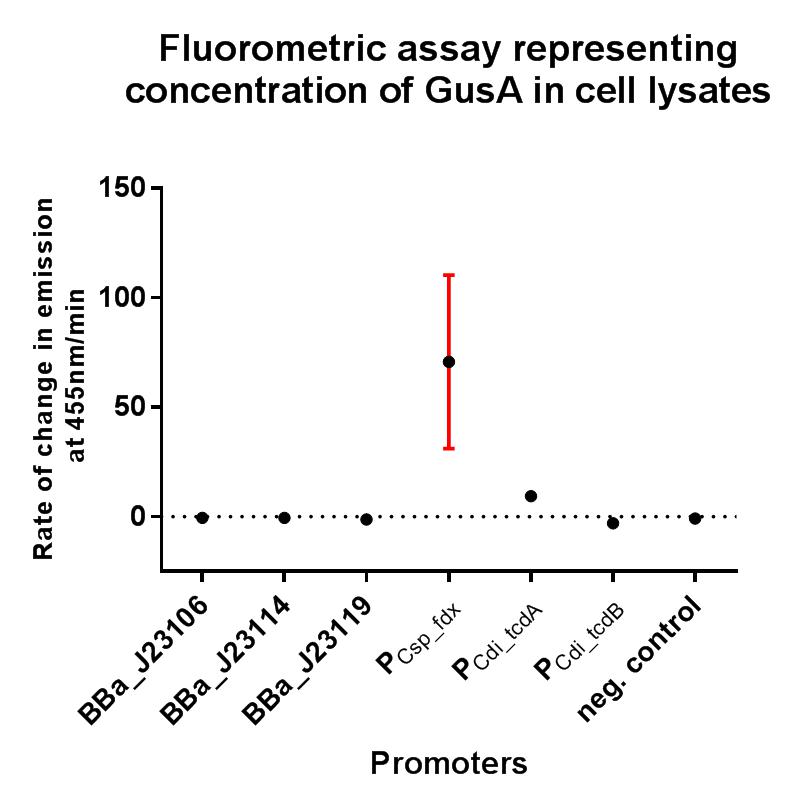Part:BBa_K2715025
Constitutive clostridial promoter Pcac_thl (BBa_K2715010), strong RBS and GusA reporter
Usage and Biology
Our project required the use of strong constitutive promoters which would function well in the non-model Gram-positive organism Clostridium difficile. We also wanted to establish whether these promoters functioned in E. coli, as this could have implications for cloning stages and vector assembly when trying to build constructs containing potentially toxic genes. In order to put the strength of these promoters into context, we decided upon a GFP fluorescence assay in E. coli using the iGEM Interlab calibration curves, and also to compare their strengths to the Interlab positive and negative controls. For characterisation in C. difficile we decided to use the reporter gene gusA. The GFP protein requires oxygen in order to fluoresce, so it isn’t suitable as a reporter gene in this context. The Β-Glucuronidase encoded by gusA functions as a very sensitive and specific reporter gene in anaerobic organisms. A substrate for the Β-Glucuronidase, 4-methylumbelliferyl glucuronide (4-MUG), can be added to the cell lysate immediately before the assay, and the production of the fluorescent compound 4-methylumbelliferone (4-MU) measured over time in a spectrophotometer.
This promoter was taken from the related species Clostridium acetobutylicum, driving expression of the thiolase gene, which has been shown in previous research to generally have strong expression in clostridial species.
Characterisation
Unfortunately despite our efforts we were unable to clone the gusA composite variant of the thiolase promoter, BBa_K2715025, despite successfully cloning all other members of this promoter library upstream of gusA. We hypothesised this was likely due to the very high strength of the promoter in E. coli, and the fact that over expression of gusA is toxic to the cells. A number of methods were attempted in order to achieve this cloning step, including changing the host strain for HB101, using a lower copy Gram-positive replicon in the plasmid backbone, and incubating the cultures at a reduced temperature. Unfortunately none of these methods enabled us to overcome the toxicity issues. The attempted composite part driving gusA is also listed in the group below:
The gusA containing composites used to assay the promoter activities in C. difficile are listed below.
BBa_K2715025
BBa_K2715026
BBa_K2715027
BBa_K2715028
BBa_K2715029
BBa_K2715030
BBa_K2715031
The plasmid used for this characterisation in C. difficile is displayed below.
Conclusions
Had the construct been made it would have been expected to produce the highest levels of gusA in the assay, being the native promoter to the RBS and being found in a species of Clostridium, and also based on pre-existing literature for related species. We also observed this promoter as having extremely high levels of expression in E. coli as was seen in the GFP assay we conducted with the Cacthl promoter in composite part BBa_K2715001.
References
Heap, J.T., Pennington, O.J., Cartman, S.T. and Minton, N.P., 2009. A modular system for Clostridium shuttle plasmids. Journal of microbiological methods, 78(1), pp.79-85.
Davis, D.F., Ward, W.W. and Cutler, M.W., 1994. Posttranslational chromophore formation in recombinant GFP from E. coli requires oxygen. In Bioluminescence and Chemiluminescence: Fundamentals and Applied Aspects. Proceedings of the 8th International Symposium on Bioluminescence and Chemiluminescence, Cambridge. Wiley, New York, NY (pp. 569-599).
Chiu, N.H. and Watson, A.L., 2017. Measuring β‐Galactosidase Activity in Gram‐Positive Bacteria Using a Whole‐Cell Assay with MUG as a Fluorescent Reporter. Current protocols in toxicology, 74(1), pp.4-44.
- 10COMPATIBLE WITH RFC[10]
- 12COMPATIBLE WITH RFC[12]
- 21COMPATIBLE WITH RFC[21]
- 23COMPATIBLE WITH RFC[23]
- 25COMPATIBLE WITH RFC[25]
- 1000COMPATIBLE WITH RFC[1000]
| None |


